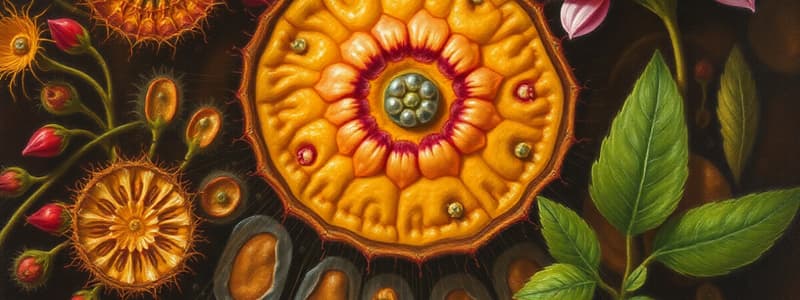Podcast
Questions and Answers
Which of the following is NOT a characteristic of living things?
Which of the following is NOT a characteristic of living things?
Which of the following demonstrates how living things respond to changes in their environment?
Which of the following demonstrates how living things respond to changes in their environment?
What is the primary role of the nucleus in a cell?
What is the primary role of the nucleus in a cell?
Which of the following is NOT a function of the cell wall in a plant cell?
Which of the following is NOT a function of the cell wall in a plant cell?
Signup and view all the answers
Which of these describes the process of photosynthesis?
Which of these describes the process of photosynthesis?
Signup and view all the answers
Which of the following is a key difference between plant cells and animal cells?
Which of the following is a key difference between plant cells and animal cells?
Signup and view all the answers
Which of the following is NOT a characteristic of a compound microscope?
Which of the following is NOT a characteristic of a compound microscope?
Signup and view all the answers
What is the purpose of magnification on a compound microscope?
What is the purpose of magnification on a compound microscope?
Signup and view all the answers
Study Notes
Characteristics of Living Things
- Living things grow, reproduce, and repair themselves
- Living things need energy
- Living things respond to changes in their environment
- Living things have a lifespan
- Living things produce waste
Plants and Animals
- Plants and animals grow larger as they age
- Living things reproduce to create offspring
- Living things repair damaged parts
- Plants use sunlight as an energy source
- Animals eat plants, other animals, or both to obtain energy
- Animals attempt to avoid predators
- Plants grow roots to find moist soil
- Living things have life cycles—they grow and die
Compound Microscope
- Used to view cells
- Uses lenses and light to magnify specimens
- Magnification increases the apparent size of a specimen
- Field of view is the area of the specimen seen through the eyepiece
Plant and Animal Cells
- Nucleus: The control center of the cell, containing genetic information (DNA) that directs all cell functions.
- Plant Cells Only: Cell wall (rigid structure that supports and protects the cell) and chloroplasts (sites of photosynthesis, where plants use sunlight to make food)
Cell Movement in Animal Cells
- Flagella and Cilia: Structures that help animal cells move.
- Flagella: Long, whip-like structures that propel the cell through the environment
- Cilia: Hair-like projections that help move the cell or substances around the cell.
Studying That Suits You
Use AI to generate personalized quizzes and flashcards to suit your learning preferences.
Related Documents
Description
Explore the fundamental traits of living organisms, including their growth, energy needs, and life cycles. Understand the role of plant and animal cells, and how a compound microscope helps in studying them. This quiz delves into the characteristics that define life and the structures of cells.




